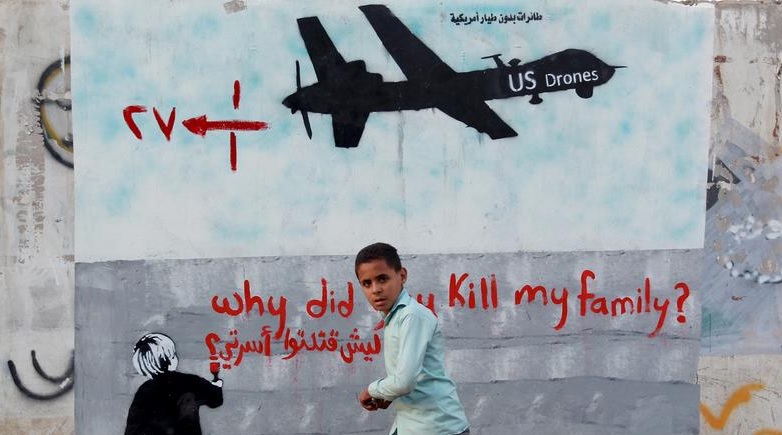An MQ-1 Predator, armed with AGM-114 Hellfire missiles in Afghanistan.
Photo: U.S. Air Force
“I no longer love blue skies. In fact, I now prefer gray skies. The drones do not fly when the skies are gray.” That’s what a young Pakistani boy named Zubair told members of Congress at a hearing on drones in October 2013. That hearing was during the Obama years at a time when the government had barely even acknowledged that an American drone warfare program existed, ‘Tom Dispatch’ blog reminds.
In 2023, USA drone warfare program has entered its third decade with no end in sight. Despite the fact that the 22nd anniversary of 9/11 is approaching, policymakers have demonstrated no evidence of reflecting on the failures of drone warfare and how to stop it. Instead, the focus continues to be on simply shifting drone policy in minor ways within an ongoing violent system.
In February 2013, White House Press Secretary Jay Carney justified drone strikes as a key tool of American foreign policy this way: “We have acknowledged, the United States, that sometimes we use remotely piloted aircraft to conduct targeted strikes against specific al-Qaeda terrorists in order to prevent attacks on the United States and to save American lives. We conduct those strikes because they are necessary to mitigate ongoing actual threats, to stop plots, prevent future attacks, and, again, save American lives.”
More aggressively endorsing the use of such drones, Georgetown Professor Daniel Byman, who has held government positions, emphasized the necessity of such warfare to protect American lives. “Drones,” he wrote, “have done their job remarkably well… And they have done so at little financial cost, at no risk to U.S. forces, and with fewer civilian casualties than many alternative methods would have caused.”
Since the war on terror was launched, the London-based watchdog group Airwars has estimated that American air strikes have killed at least 22,679 civilians and possibly up to 48,308 of them. Such killings have been carried out for the most part by desensitized killers, who have been primed towards the dehumanization of the targets of those murderous machines. In the words of critic Saleh Sharief, “The detached nature of drone warfare has anonymized and dehumanized the enemy, greatly diminishing the necessary psychological barriers of killing.”
Needless to say, drone technology has rendered those in distant lands so much more disposable in the name of American national security. This is because such long-range techno-targeting has created a profound level of dehumanization that, ironically enough, has only made the repeated act of long-distance killing, of (not to mince words) slaughter, remarkably banal.
While the use of drones in the war on terror began under President George W. Bush, it escalated dramatically under Obama. Then, in the Trump years, it rose yet again. Halfway through Trump’s presidency, drone strikes had already exceeded the total number in the Obama era. Though the use of drones in Joe Biden’s first year in office was lower than Trump’s, what has remained consistent is the lack of the slightest accountability for the slaughter of civilians.
In 2021, as the U.S. was withdrawing chaotically from its 20-year Afghan War disaster, its military surveilled a white car driving around Kabul, believed it to be carrying explosives, and launched its final drone strike of that conflict, slaughtering 10 Afghans. Two weeks later, after reporting by the New York Times revealed what really happened, the Pentagon finally admitted that only civilians had been killed, seven of them children (but penalized no one).
A few weeks ago, thanks to a Freedom of Information Act request, the Biden administration was forced to release a redacted version of a presidential policy memorandum, signed in October 2022, that detailed the administration’s latest approach to drone warfare globally. At least some details about it were known prior to its release, however, thanks to an anonymous senior administration official.
The Washington Post editorial board, among others, celebrated the memo, arguing that the restrictions in place are “smart rules of engagement” and a significant improvement over the Trump years when it comes to limiting civilian damage from drones. In reality, however, Biden’s memo is likely to do little to stem future drone warfare nightmares. In essence, the memo represents a return to Obama-era rules...
Twenty-two years later, drones continue to be instruments of civilian slaughter and the language deployed by successive administrations to describe such slaughter has served to sanitize that fact. Whether it’s the use of “target” or “collateral damage,” both minimize the reality that human beings are being murdered.
In Sana’a, Yemen, a wall with graffiti art shows a U.S. drone under which someone has written in blood-red paint, “Why did you kill my family?” in English and Arabic…

read more in our Telegram-channel https://t.me/The_International_Affairs

 11:20 12.09.2023 •
11:20 12.09.2023 •























